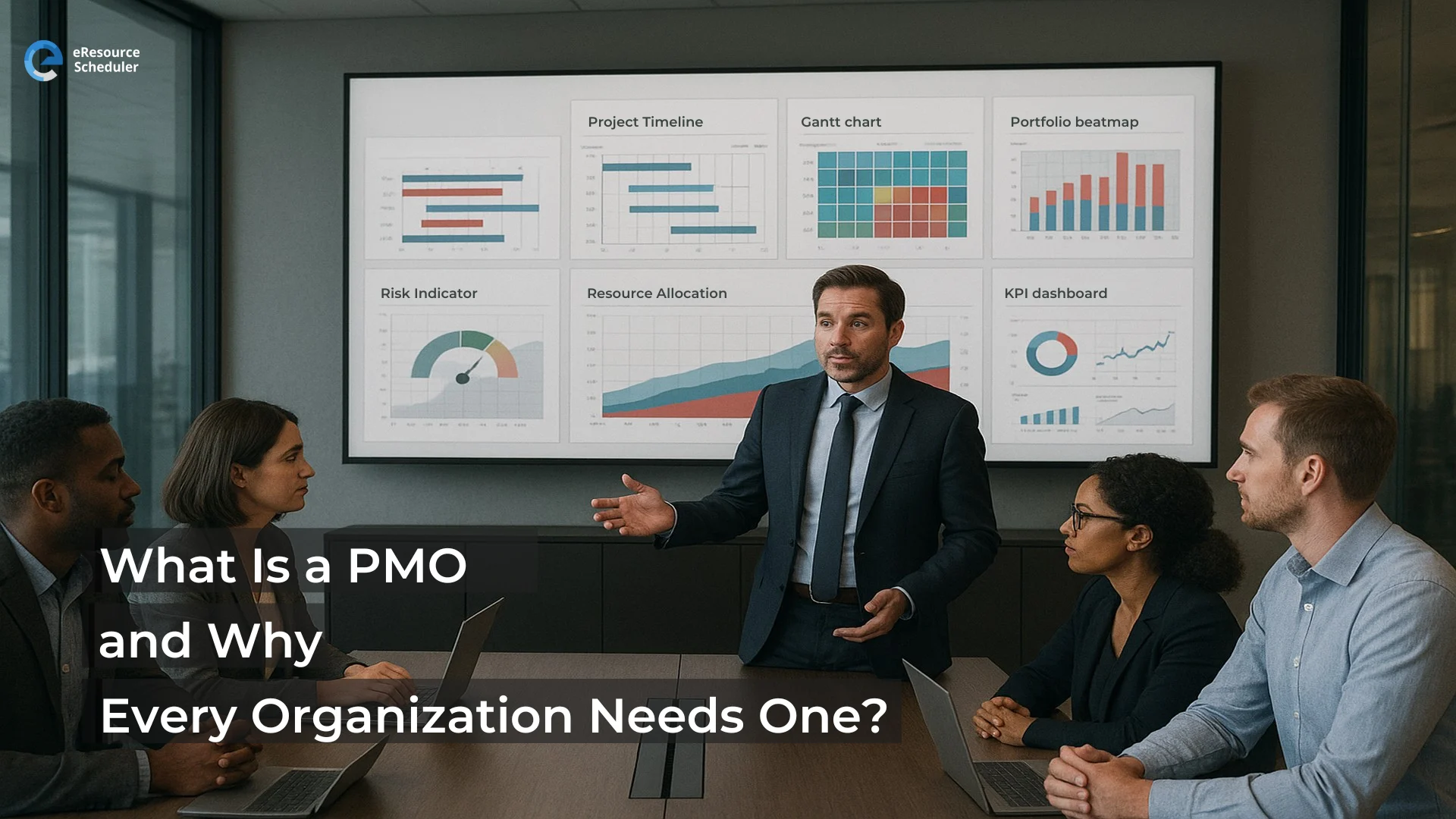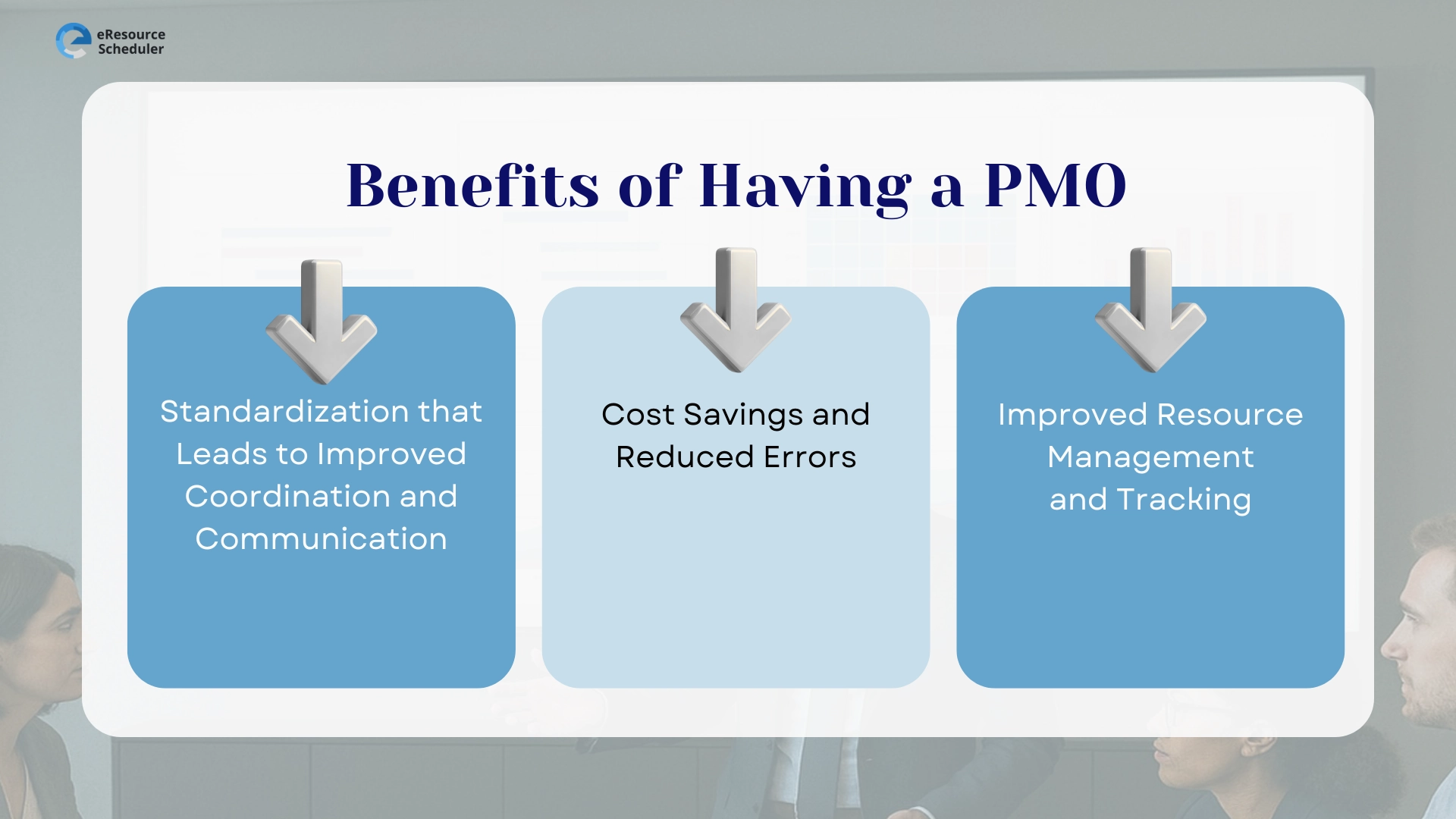
Projects slip. Budgets stretch. Deadlines wobble. In a fast-moving business landscape, even strong project teams sometimes need added structure and guidance to keep delivery sharp. That’s where a project management office steps in. A PMO brings consistency, support, and oversight so project work stays aligned, on track, and worth the investment.
This blog breaks down what a PMO actually is, how it strengthens business performance, and how resource management software can help.
A Project Management Office is a dedicated function that sets the standards, practices, and reporting frameworks your organization follows for project execution.
Think of the PMO as the team focused on making every project more predictable, more efficient, and more profitable. It creates the guardrails and insights that help teams deliver stronger outcomes with fewer surprises.
The primary responsibility of the PMO is to make sure all projects are executed following appropriate (standardized) processes and procedures. They are the central point of contact for any information regarding any project for all stakeholders (upper management, clients, finance team, etc). The PMO ensures that all data, statistics, and other relevant information about a project are up-to-date and verified.
Let’s take a look at the key roles the PMO plays in further detail.
Just as the main chef curates a recipe for their most prized dishes for others to follow, the PMO establishes the main, centralized procedures for the successful execution of any project.
The PMO establishes the format of how a project should be defined, prioritized, communicated, and executed. Furthermore, the office also decides how resources will be allocated and highlights the standardized metrics against which project success is measured.
Aspects of resource planning that can be streamlined by PMO include:
The benefits of standardizing include rapid completion of projects, as everyone knows what they have to do (this eliminates confusion), and the establishment of best practices.
PMO is also in charge of setting up a governance structure that includes an ongoing risk assessment of the projects and the development of migration strategies to reduce negative impacts and unfavorable circumstances.
The PMO is also in charge of prioritizing projects so that not only the most crucial ones get completed, but also ones that align with the company’s short and long-term goals.
To do this properly, the PMO or members generate a prioritization criterion that integrates historic project data, the business’s operational and strategic goals, and other key performance indicators (KPIs).
One of the main responsibilities of the PMO is resource planning. Resources are the most expensive cost of a project, and the majority of the project’s success depends on the right people being available to work on the crucial tasks.
Effective and efficient resource planning and scheduling will establish the following precedence:
Once the PMO has designed the most efficient way to identify, allocate, and track resources, they also need to be able to build resource capacity plans and forecast models. This responsibility is crucial for the company’s ability to take on and deliver successful projects in the long run.
Resource capacity planning provides insight into how many hours a task will take and whether there are enough hands on deck to complete the assignment. This tool ensures that all resources are working to their maximum efficiency and that the projects will be completed within budget and deadline.
Some of the common forecasts generated by the PMO include:
As the PMO is the central communication point for all projects, it is responsible for communicating project status and all key data to the appropriate stakeholders on time. This will ensure the right decisions are made, profits are maximized, and risks are avoided.
Key reports prepared and delivered to relevant stakeholders by the PMO are:
As a member of the PMO team, one is also responsible for providing adequate support, mentorship, and training for project leaders and team members. This support can come in the form of providing ongoing training on best project management practices, consistently reviewing project plans and templates to make sure they are being used properly, and providing mentorship.
Issues that can be handled by the PMO team could be how to resolve internal project conflicts quickly, how to identify each member’s strengths, and how to facilitate employee engagement.
Members of the PMO are often simple spectators of the daily workings of a project and its tasks. Therefore, they can offer an objective and qualitative perspective on the quality of a project or highlight an issue that others may not notice. They can easily identify areas for improvement and provide constructive feedback.
For instance, someone from the PMO may identify that a resource is close to its maximum capacity and can inform the team leader to take corrective action immediately. This will result in the identified resource being able to work efficiently and without stress.
Now that we understand the roles and responsibilities of a PMO, let’s discuss the various types of PMO structures an organization can opt to have.
The three types of PMO structures are defined by the degree of control they have over the projects.
These structures are defined by the level of participation the PMO has in the project phase:
There is no one right type. Ultimately, how you set up your PMO completely depends on your business’s needs and goals.

A PMO does much more than just support projects. The office impacts a company’s long-term growth, profitability, and overall value proposition in the marketplace. Other benefits of having a dedicated project management office in your business are discussed in further detail.
Businesses use the PMO to standardize project processes and communication channels for their business.
Think about this: without standardization, two project managers might write two different types of project reports. Then there is no way for upper management to objectively compare the two projects. Standardization increases the overall efficiency within the company.
With a PMO, everyone knows who to direct their concerns to about a project or who to reach out to in regards to getting help. The PMO reduces confusion and builds streamlined communication channels.
In addition to delivering substantial cost savings, PMOs also reduce the number of errors within a project. For instance, with the help of a PMO member, project leaders can assign the right resource for every task. This will reduce the chances of people committing mistakes because they have the right skill set and expertise for the job.
With the constant monitoring and diligence that PMOs are in charge of, they are capable of identifying risks and potential errors. They can therefore identify and fix the mistakes early on or at times even before they happen.
The PMO team ensures that not only do projects have access to the best talent for each task, but they also monitor the utilization of each resource. This means they make sure that each resource is working at optimal levels and thus maximizes productivity. The resource tracking managed by the PMO helps organizations prevent burnout and attrition.
Monitoring resources will also enable the PMO to ensure that the majority of the top resources are given strategic and billable tasks. This will generate more revenue and positively impact the company’s growth prospects.
A successful PMO stands on clarity, buy-in, smart people, and tools that keep decisions honest. Here’s the fast path:
A strong PMO thrives on visibility, speed, and smart allocation. eResource Scheduler brings all three together. It sharpens project standards, forecasts demand, flags shortages, and matches the right talent to the right work so performance scales without chaos. Take a sneak peek into this versatile software by starting the 14-day free trial now.
1. What exactly does a PMO do for an organization?
A PMO sets standards and governance for how projects are defined, prioritized, staffed, and reported. It centralizes risk management, standardizes delivery practices, and delivers the data executives need to make portfolio-level decisions.
2. How does a PMO improve project profitability?
By enforcing consistent estimation, matching skills to billable work, spotting capacity shortfalls early, and improving utilization. That reduces rework and bench time while increasing margin on delivered projects.
3. Which PMO type is right for a growing company?
If influence is needed more than control, start with a supportive PMO. If fast, consistent delivery across the portfolio is the goal, then move to a controlling or directive model. The right choice depends on culture, risk tolerance, and strategic alignment.
4. How does a PMO make resource planning reliable?
A PMO designs capacity models and forecasting rules and then enforces a single source of truth for resource availability, skills, and assignments. That prevents double booking, unlocks true utilization metrics, and enables proactive hiring or bench strategies.
5. What tools should a PMO use to be effective?
A PMO needs real-time visibility into projects and people. Use tools that combine resource capacity planning, demand forecasting, and portfolio reporting so the PMO can prioritize, reassign, and report with evidence rather than guesswork. eResource Scheduler is one example that centralizes capacity forecasting, conflict detection, and utilization reporting to give a PMO actionable control.
Plan Smarter. Schedule Faster.
Join thousands already using eResource Scheduler to align teams, time, and tasks seamlessly.